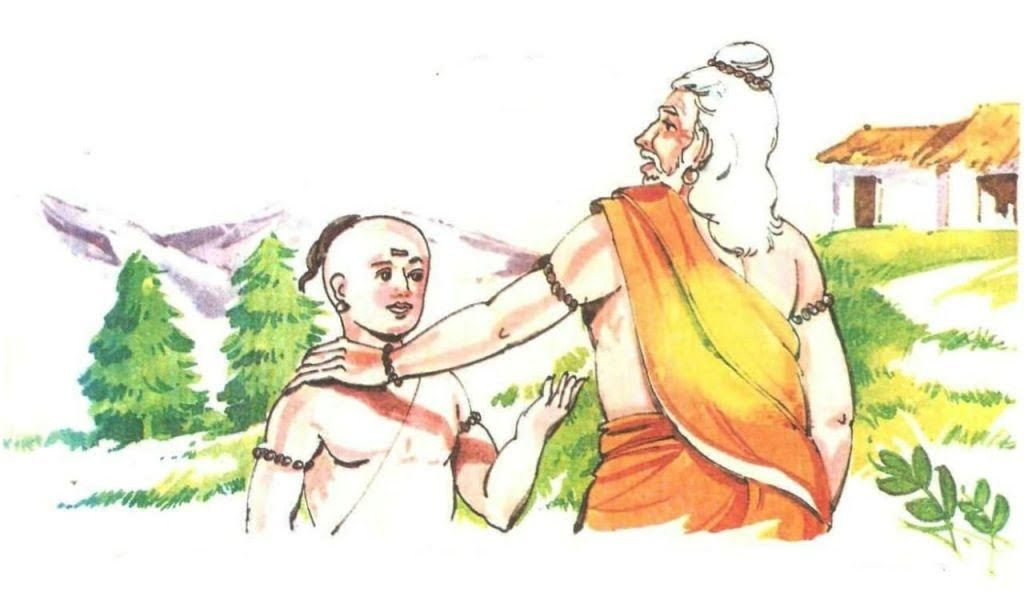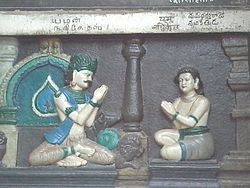No products in the cart.
Nachiketa
Nachiketa was the son of the sage Vajashravas and was also known as Nachiketas or Nachiketan (lit. famous for donations). In an old Indian narrative concerning the nature of the atman, he is the kid protagonist (soul). Though the term has multiple previous allusions, the narrative is described in the Katha Upanishad (c. 9th century BCE). Lord Yama, the Dharmaraja, gave him self-knowledge, as well as knowledge of the atman (soul) and Brahman (ultimate reality). Nachiketa is known for rejecting transient material cravings and pursuing the road of salvation/Moksha, i.e. self-knowledge, with a single-mindedness.
The masculine term Nachiketa has several meanings, all of which are interconnected. It’s essentially a mash-up of three words- न+ चि+ केतृ. न (na) means denial, चि (chi) means Chaitanya (चैतन्य), i.e. unending spiritual energy and केत/ केता/ केतस्/ केतन् which is a short form of ketu (केतु) meaning continuous revolving action. As a result, the name literally means “one who does not lose his energy in an infinite circle.”

There are, however, different interpretations of the name:
- That which goes unnoticed.
- The quickening Spirit that is latent in all things, such as wood.
- The spirit that satisfies an insatiable desire for the unknown.
- a blaze (in simple terms).
Puranas name the first emerging fire Nachiket because fire is regarded to be one of the sacred and pure elements in Hinduism.
Yama and a kid are mentioned in Rigveda 10.135, which might be a connection to Nachiketa. In the Taittiriya Brahmana, 3.1.8, he is named as well. Later in the Mahabharata, the name occurs as one of the sages in King Yudhishthira’s Sabha (royal assembly) (Sabha Parva, Section IV), as well as in the Anusasana Parva (106). The main tale, which concerns Nachiketa and Yama’s debate, is found in the Katha Upanishad, which is recounted here.
Yama
Yama is the deity of the dead in Indian mythology. According to the Vedas, he was the first man to die, foreshadowing the road of death that all people have since followed. He is the protector of the south (the area of death) and presides over the under-the-earth resting place of the deceased. Yama was depicted in the Vedas as a happy monarch of the dead, not as a punisher of crimes, but in later mythology he became known as the righteous judge (Dharmaraja), who assesses the good and evil actions of the dead and determines vengeance. His appearance is described as majestic, with green or black skin, crimson eyes, and red clothes. He mounts a buffalo and wields a noose and a mace, which may be adorned with a skull. The crow and the pigeon serve as his messengers, while his two four-eyed canines protect the entrance to his dominion. Yama has also made his way into Buddhist mythology in Tibet, China, and Japan, where he serves as the gatekeeper of the afterlife in a similar but smaller function.

The Chitral district is located near the Chitral river in the Swat (Suvastu) area of the Indian subcontinent. Chitrali and Kalash are two of the languages spoken. It’s worth noting that specific deities were worshipped in one community/tribe or another, even in the last remaining version of ancient Hinduism in the region. The ancient Hindu deity Yama Raja, also known as imr’o in Kamviri, was universally venerated as the Creator. The ancient territory has historical and cultural ties to Gilgit-Baltistan, Kashmir, and Nooristan, which were all close. Srivastava clan is supposed to have originated in the Srivastu/Suvastu area.
Yama is also one of the Lokapalas (guardians of the directions), and has been designated as the defender of the south. Yama is described as having four arms, protruding fangs, and a wrathful expression; surrounded by a garland of flames; dressed in red, yellow, or blue garments; riding a water-buffalo and holding a sword, noose, and mace to capture the souls of those who have sinned; and riding a water-buffalo and holding a sword, noose, and mace to capture the soul He is said to be the twin of Yamuna, the river goddess of life, and the son of the Sun deity Surya and Saranyu, according to legend. He had several siblings, including the Ashvins, Shani, Shraddhadeva Manu, Revanta, and Tapati, in addition to Yamuna. In the legends of the Pandavas, Savitri Satyavan, and the sage Markandeya, he makes several prominent appearances. Chitragupta, another death-related deity, is his helper.
Nachiketa and Yama
Vajashravasa began an offering to devote all of his possessions to the gods, wanting a reward from the gods. But Nachiketa, his son, discovered that Vajashravasa was only providing elderly, barren, blind, or lame cows, not those that might be used to purchase the worshipper a spot in paradise. “I too am yours, to whatever God would you offer me?” Nachiketa inquired, seeking the best for his father’s ceremony. “I surrender you unto Yamaraja Himself!” Vjashravasa said angrily after being harassed in this manner.

So Nachiketa went to Yamaraja’s house, but Yama was away, and he had to wait three days for food and water. When Yama returned, he was disappointed to learn that a Brahmin visitor had been left hungry and thirsty for such a long time. Guests are considered comparable to god in Indian tradition, and causing difficulties for god is considered a major sin. “You have waited at my house for three days without hospitality, therefore beg three boons from me,” Yama instructed Nachiketa to make amends for his error. When Nachiketa returned to his father, he first pleaded for peace for his father and himself. Yama concurred. Nachiketa then wanted to hear about the sacred fire sacrifice, which Yama also explained. Nachiketa’s third boon was to discover the enigma of what happens when the body dies.
Yama was a little hesitant when it came to answering this question. He claimed that even the gods couldn’t figure out what was going on. He told Nachiketa to beg for another boon and promised him a lot of money.
However, Nachiketa responded that material goods are fleeting and do not bestow immortality. As a result, no other boon would suffice. Yama was secretly pleased with this pupil and went into detail on the nature of the real Self, which lives on after the body dies. The realization’s essential is that this Self is inextricably linked to Brahman, the highest spirit and the universe’s life force. Yama’s explanation is a concise Hindu metaphysics explanation that focuses on the following points:
- The sound Om! is the highest Brahman’s phrase.
- The ubiquitous Brahman is the same as the Atma, whose emblem is Om. The Soul is formless and all-pervading, smaller than the smallest and greater than the largest.
- The knowledgeable seek to understand this Atma.
- The Atma is a rider, and the senses are his horses, which he leads through the labyrinth of wants.
- The Atma is the only thing that survives death; the Atman is everlasting.
- Atma cannot be realised via only reading the scriptures or cerebral study.
- The Atma must be distinguished from the body, which is the seat of desire.
- When one is unable to realise Brahman, they become entangled in the cycle of rebirths. Moksha is attained via self-awareness.
Nachiketa returned to his father as a jivan-muktha after learning the Brahman wisdom from Yama.
Nachiketa is regarded as one of Hinduism’s most prominent figures. “If I have 10 or twelve youths with the faith of Nachiketa, I can change the ideas and interests of this country into a new course,” Indian monk Swami Vivekananda declared.






